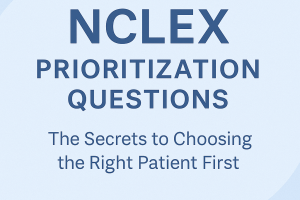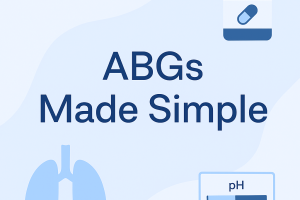NCLEX Medication Prefixes & Suffixes: A Pharmacology Shortcut

Pharmacology is one of the most challenging topics for NCLEX test-takers, and memorizing hundreds of drug names can feel overwhelming. However, a simple and effective shortcut is to learn medication prefixes and suffixes. These can help you quickly identify a drug’s class, mechanism of action, and potential side effects.
In this guide, we’ll break down the most important medication prefixes and suffixes that frequently appear on the NCLEX.
Why Learn Medication Prefixes and Suffixes?
✅ Faster recall during the NCLEX exam – If you recognize a suffix, you can quickly determine the drug’s purpose.
✅ Helps with critical thinking – Knowing the drug class can help you anticipate side effects and nursing interventions.
✅ Saves time on memorization – Instead of memorizing every drug individually, you can group them by common patterns.
Common NCLEX Medication Prefixes & Suffixes
1. Beta-Blockers (-olol)
- Examples: Metoprolol, Atenolol, Propranolol
- Action: Decreases heart rate and blood pressure
- Used For: Hypertension, angina, arrhythmias, heart failure
- Key Side Effects: Bradycardia, hypotension, fatigue, dizziness
NCLEX Tip: Monitor blood pressure and heart rate before administration. Do not give if the patient is bradycardic.
2. ACE Inhibitors (-pril)
- Examples: Lisinopril, Enalapril, Captopril
- Action: Lowers blood pressure by blocking angiotensin conversion
- Used For: Hypertension, heart failure
- Key Side Effects: Dry cough, hypotension, hyperkalemia, angioedema
NCLEX Tip: If a patient develops a persistent dry cough, they may need to switch to an ARB (-sartan).
3. ARBs (-sartan)
- Examples: Losartan, Valsartan
- Action: Blocks angiotensin receptors to lower blood pressure
- Used For: Hypertension, heart failure
- Key Side Effects: Hyperkalemia, hypotension, dizziness
NCLEX Tip: ARBs are often given to patients who cannot tolerate ACE inhibitors due to the dry cough.
4. Calcium Channel Blockers (-dipine, -zem, -amil)
- Examples: Amlodipine, Nifedipine, Diltiazem, Verapamil
- Action: Relaxes blood vessels and reduces heart workload
- Used For: Hypertension, angina, arrhythmias
- Key Side Effects: Hypotension, dizziness, edema
NCLEX Tip: Avoid grapefruit juice, which can increase drug toxicity.
5. Loop Diuretics (-ide)
- Examples: Furosemide, Bumetanide, Torsemide
- Action: Promotes diuresis by inhibiting sodium and water reabsorption
- Used For: Edema, heart failure, hypertension
- Key Side Effects: Hypokalemia, dehydration, ototoxicity
NCLEX Tip: Monitor potassium levels and watch for signs of dehydration.
6. Antibiotics (-cillin, -mycin, -cycline, -floxacin, -cef/ceph)
- Examples: Amoxicillin, Azithromycin, Doxycycline, Ciprofloxacin, Ceftriaxone
- Used For: Bacterial infections
- Key Side Effects: GI upset, allergic reactions, superinfections
NCLEX Tip: Ask about allergies before giving penicillins (-cillin) or cephalosporins (cef-/ceph-).
7. Antifungals (-azole)
- Examples: Fluconazole, Ketoconazole
- Used For: Fungal infections
- Key Side Effects: Liver toxicity, nausea, vomiting
NCLEX Tip: Monitor liver function tests during prolonged use.
8. Proton Pump Inhibitors (-prazole)
- Examples: Omeprazole, Pantoprazole, Esomeprazole
- Action: Reduces stomach acid production
- Used For: GERD, ulcers
- Key Side Effects: Osteoporosis (long-term use), increased risk of infections
NCLEX Tip: Take 30 minutes before meals for best absorption.
9. HMG-CoA Reductase Inhibitors (Statins -statin)
- Examples: Atorvastatin, Simvastatin, Rosuvastatin
- Action: Lowers cholesterol
- Used For: Hyperlipidemia
- Key Side Effects: Muscle pain (myopathy), liver damage
NCLEX Tip: Avoid grapefruit juice and monitor liver enzymes.
10. Insulins (-log for rapid-acting, -lin for intermediate/long-acting)
- Examples: Lispro (Humalog), Aspart (Novolog), Glargine (Lantus)
- Used For: Diabetes management
- Key Side Effects: Hypoglycemia
NCLEX Tip: Rapid-acting insulin (-log) should be given within 15 minutes of a meal.
How to Study Medication Prefixes & Suffixes Effectively
✅ Use Flashcards: Write the suffix on one side and drug details on the other.
✅ Group Drugs by Class: Memorize medications by function, not just individual names.
✅ Create Mnemonics: For example, “-pril gives you a dry thrill” to remember that ACE inhibitors (-pril) cause a dry cough.
✅ Take NCLEX Practice Questions: Apply your knowledge in test scenarios.
✅ Use Visual Aids: Charts and tables can help reinforce patterns.
Final Thoughts
Learning medication prefixes and suffixes is one of the best ways to simplify NCLEX pharmacology. By recognizing common patterns, you can quickly recall drug classes, their uses, and key side effects—giving you an edge on exam day.






